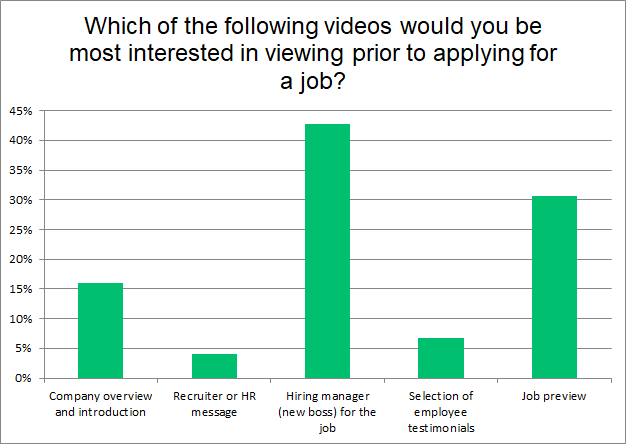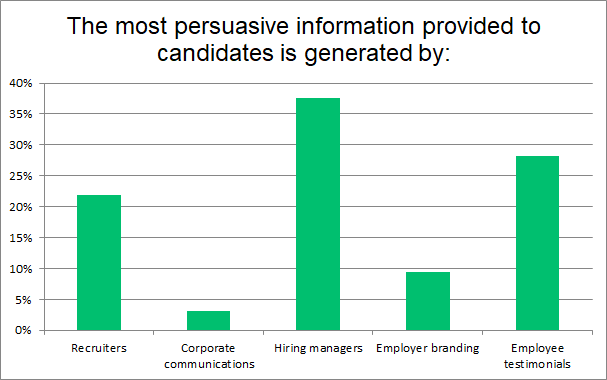Candidates: Are you interviewing and need support?
When it comes to recruiting videos, is there any value in high production values? That’s the question Lighthouse Research looked to answer a couple weeks ago in a study titled “The Role of Video in the Candidate Experience.”
What Kind of Video Builds The Most Credibility with Candidates?
According to the survey, 55% of active job said employee-generated video would be more credible/trustworthy than company-produced video. In other words, candidates are more likely to trust a recording a hiring manager made in their office than a high budget company overview video. On closer inspection, this shouldn’t be a surprise. Hearing an individual share their experiences and expectations is always going to have a greater impact on trust than an overview targeted at a more general audience.
The Credibility Holy Grail: Videos Made By Hiring Managers
It’s pretty clear from this particular survey that videos created by hiring managers are the “holy grail” of job-specific video content. Not only do job seekers prefer it:
 Lighthouse: "2017 Video and the Candidate Experience Study" Employers who completed the survey say it’s the most “persuasive information” you can provide to candidates:
Lighthouse: "2017 Video and the Candidate Experience Study" Employers who completed the survey say it’s the most “persuasive information” you can provide to candidates:
 Lighthouse: 2017 Video and the Candidate Experience Study At this point in time, hiring manager-created video is effectively an untapped resource. Despite candidates and employers acknowledging its value, only 3% of employers said they were using it to attract job seekers. In a competitive job market at full employment, this is a great opportunity to make your job opportunities stand out. So how do you get your hiring managers to create video content for their open roles? We’ve laid out a three step process that will help your chances.
Lighthouse: 2017 Video and the Candidate Experience Study At this point in time, hiring manager-created video is effectively an untapped resource. Despite candidates and employers acknowledging its value, only 3% of employers said they were using it to attract job seekers. In a competitive job market at full employment, this is a great opportunity to make your job opportunities stand out. So how do you get your hiring managers to create video content for their open roles? We’ve laid out a three step process that will help your chances.
Getting Hiring Managers to Film Themselves, Step 1: Show Them the Data
Fortunately, Lighthouse has you covered here. It turns out that hiring manager video has a direct impact on how likely a candidate is to apply. Respondents indicated that hiring manager-created video would make them:
- 46% more likely to consider the job.
- 30% more likely to apply.
It’s not too much of a logical leap to assume that these are the candidates you want. During a time of record employment, your best candidates are already employed (or at the very least have options). Since the stakes are significantly lower for these passive candidates, getting them interested requires some extra effort.
Getting Hiring Managers to Film Themselves, Step 2: Remove Barriers to Entry
Asking hiring managers to film themselves is a huge request, particularly if they have no experience filming themselves. Think about the back-and-forth it takes to put together a job description - now throw a camera (usually a front-facing smartphone camera) into the mix. To increase the chances a hiring manager will “pitch” their open roles on video, you need to provide a specific action plan that lays out everything from the technical aspects of filming to content expectations. Here are some examples to get you started:
- Film with quality lighting. This small detail can make or break a video. Videos shot with bad lighting will need to be refilmed.
- Don’t worry about stumbling over words (to a certain extent). When people talk, they make mistakes: including those mistakes helps build credibility and establishes authenticity. But if you make a major error, you can choose to start over from the beginning, or from the previous sentence if you’re comfortable with us editing the video.
- Show off the workspace. Film in more than one place. Walk around the office to give candidates an idea of where they can expect to do the majority of their work.
- Focus on authenticity over quality. Ideally this video will attract the candidate you ultimately end up hiring. Try not to “play a character” - be yourself.
- Sell the role. Don’t just lay out job expectations. Share the team’s past accomplishments, explore advancement opportunities, and outline “a day in the life” for each role.
- Outline a list of topics if you’re uncomfortable speaking off the cuff. Creating a list of topics you plan to cover will help you mentally structure your pitch - making it much easier to present when the camera is rolling.
The key here is to provide hiring managers as much direction as possible. Creating one action plan for all your hiring managers is much easier than hoping each will figure it out themselves.
Getting Hiring Managers to Film Themselves, Step 3: Give Them FOMO
Once two or three hiring managers take the plunge, making the case to your other hiring managers becomes much easier. By showing hesitant hiring managers the videos made by their coworkers, you:
- Set the expectation that this is the new normal.
- Dispel reservations like “What if my video doesn’t look professional enough?”
- Give them a better idea of how it’s done.
Eventually your recruiters will be able to give examples of quality candidates (and ideally new hires) that were inspired to apply by each hiring manager’s video. Once they see the quality applicants they’re missing, and the relatively small amount of time required to make a video, even the most reluctant hiring managers will start pitching their open roles. So where does that leave us with the traditional, high-quality company overview video?
The Case for a High-Quality Company Video
It’s clear that from a credibility perspective, employee-created video content is tough to beat. But is the primary purpose of high-quality, company-produced video to build the sort of trust and credibility that a job-specific video does? Not really. Just take a look at the New Zealand Police Force’s most recent recruitment video. It’s one of the most entertaining recruiting videos on the internet, but it’s certainly not an exercise in trust-building. That’s a good thing. When it comes to building trust and credibility, you just can’t beat personalization and specificity - and you shouldn’t try. What a high quality, company-produced video should do is more in line with what a Super Bowl commercial does: grab mental real estate on a large scale. It’s not news that today’s candidate’s attention is drawn in more directions than ever. The power of engaging, high-quality video is still unmatched when it comes to grabbing that first, essential bit of attention. To convince the most competitive candidates to apply, you need two types of content: the type that grabs their attention, and the type that builds their trust. You can get away with one or the other, but you need both to fully optimize your recruiting funnel. It’s a classic example of the buyer’s journey (or job seeker’s journey): as they move through the decision-making process, the content they see should evolve from attention-grabbing and to specific. Let’s be clear: professionally shot and edited video is expensive. For budget-constrained TA departments without access to in-house video production, spending $5,000, $10,000, or $20,000 on a single video probably isn’t the best use of funds (especially since you’ll need to update it in the next year or two anyway). But if you do have the budget, you shouldn’t let this research dissuade you from refreshing your old company video. If these survey results persuade you of anything, it should be the importance of getting your hiring managers to pitch their jobs on camera - something that can be done regardless of budget.
Are you losing candidates at your career site? If so, you're not alone: career page conversion rates fell 22% this year.


